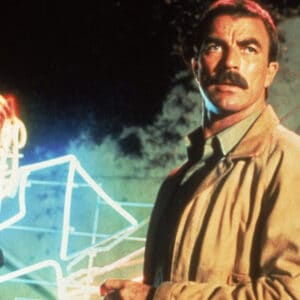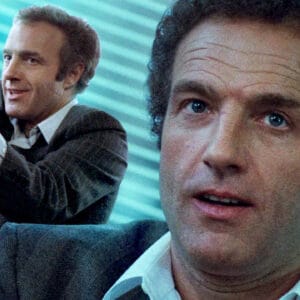
Welcome to The Best Movie You NEVER Saw, a column dedicated to examining films that have flown under the radar or gained traction throughout the years, earning them a place as a cult classic or underrated gem that was either before it’s time and/or has aged like a fine wine.
This week we’ll be looking at SIDE EFFECTS.

THE STORY:
Her charming husband arrested for insider trading, Emily Taylor (Mara) turns to a psychiatrist (Law) who prescribes a new drug that sends her into a spiral of violence and depression. And that's before he sees for himself that things may not be what they seem, but that perhaps he has glimpsed the truth too late…
THE PLAYERS:
Writer Scott Z. Burns. Director Steven Soderbergh. Actors Jude Law, Catherine Zeta-Jones, Rooney Mara, and Channing Tatum.
THE HISTORY:
Originally titled The Bitter Pill, SIDE EFFECTS marks the third collaboration between screenwriter Scott Z. Burns and director Steven Soderbergh following THE INFORMANT! and CONTAGION. It also rather famously a marks what is meant to be the hardworking director’s feature film swan song, and a fascinating choice for that it is. While initially working on what eventually became Guy Ritchie’s latest release THE MAN FROM U.N.C.L.E. Soderbergh was reading drafts of the script purely as Burns’ friend. Burns had initially planned to direct himself, but after U.N.C.L.E. fell apart Soderbergh called Burns in November and said “I want us to be working together in April. Would you consider me doing this?”
This being the film business, nothing’s that easy. And SIDE EFFECTS too nearly came apart when financing fell through 3 ½ months before the shoot and Blake Lively (cast initially in the role that became Rooney Mara’s) was forced to drop out. After three or so days of scrambling and call-making, Soderbergh had new funding and a new lead actress through the connection of his personal friendship with fellow filmmaker David Fincher. The shoot flew through its two months, sailing all the way past a first edit – and then delay came again when composer Thomas Newman was unavailable for four months. So Soderbergh shot his HBO piece BEHIND THE CANDELABRA while he waited, and the movie, with all its twists and turns (in both production and narrative) released on February 8th, 2013 before reaching a final box office total of a little over $63 million against a budget of about half that.

The amount of time spent on the first 35 minutes of the film, proportionally, was more than on any other movie I've ever made, including Contagion, which went through a lot of permutations in post. Finding the balance of how to do the first act took a lot of trial and error. Removing material, putting it back, restructuring. Some strategic reshooting. The back two-thirds of the movie fell into order very quickly. But the first 35 minutes were really, really tricky… there's no algorithm to apply that will tell you definitively whether or not something will stick to an audience-or if it does stick, for how long. We were seeding certain ideas that would pop up later and the degree to which they were imprinting - it was really just a matter of screening the movie over and over again. – Steven Soderbergh
WHY IT'S GREAT:
According to Soderbergh, they initially met with a studio a Friday that said “this is a slam dunk, we want to do it." Come Monday, however, their tune had changed, and they said they wouldn’t be involved after all because their marketing department didn’t “know how to sell it.” Admittedly, hardly unheard of in Hollywood.
But as frustrating as that may have been for him and all involved as they tried to make sure people would see the movie, unnamed studio executive was right in their way. Once one gets beyond the creative team and the inherent filmmaking quality, SIDE EFFECTS is a tough sell precisely because of the core element that makes it so great. There’s a very Hitchcockian quality to the whole thing, to the point that if you miss opening scenes it would be best if you just started over. The entire thing is an interwoven tapestry of mind-f***ery, concerned first with the story its telling and a close second with the subject matter it’s trying to talk about. It’s a movie that rewards both close attention and repeat viewings, complicated with both intention and purpose as you work out who is really doing what to whom and why.
In my experience, there are two kinds of bad “thriller" out there. One kind which misinterprets why MULHOLLAND DRIVE works so well and takes what they think they it does to an extreme, mistaking excessive convolution for character complexity and moral revelations. Others take pride in harkening back to minute details that any reasonable filmgoer might miss because the creators purposefully made the film and its progressions weird and difficult to follow. Then there’s SIDE EFFECTS, a more classical kind which tells one story on a first viewing before evolving into a new yet still completely satisfying story on the second once know the narrative's weave you and understand the characters. Characters – brought to life by carefully crafted and calculated performances from everyone involved – who make complex decisions for reasons equally rational and irrational. Kind of like, you know, real-life human beings.
But don't take my word for it. As Burns himself said,“the movie itself is not what it appears to be, and it reflects how hard it is to know the internal state of another.”

I kind of graded [my character Dr. Jonathan Banks] throughout. There was the comfortable—you could almost argue a little bit smug—‘perfect life’ at the beginning, and then the deterioration, the revelation, and then of course him trying to put it back together and seek some kind of redemption or revenge, even. All of that really, the twists and turns were in the script, so sometimes you just have to stick to playing it for real and bring commitment… there was an interesting element that we did talk about, that we wanted to feel at moments, ‘Who was the mad person?’ – Jude Law
Jude Law plays Dr. Jonathan Banks, a psychiatrist who adds a new patient and a the trial of new medication to his already very-piled plate of responsibilities. Prescribing the medication comes with certain perks, of course, and Rooney Mara’s Emily seems to be a prime candidate. Little does he know how that pair of small, business-as-usual steps that he has taken a thousand times before will send him tumbling down into a pit of despair and dismay as Emily experiences dangerous side effects that threaten to tear his world down and burn the scraps for fun.
The medical world as seen through the pharmaceutical prism is a murky one, built on what is arguable a self-propagated platform manufactured by the sculpting forces of fear and salvation (sold for $X.XX a bottle multiplied by a cabinet full of bottles for every cause and concern). Search “side effects of” on Google and you’ll be soon be able to scroll through a bevy of drugs and diseases, many of them born only in the wake of diagnosis of or treatment for every other thing you’ve read about. It’s a scary world, regulated by loopholes and opportunism, and the absolute perfect setting for a thriller firmly rooted in contemporary fears even as we follow the tendrils they stretch into our very possible future.
Burns ensured he researched meticulously, trailing a forensic psychiatrist for months at Bellevue Hospital, speaking with patients who had committed crimes, exploring the gilded subterranean cave that is the subway intersection of legality, psychiatry, and psychopharmacology, and in the process of all that discovered something vitally important: “we are getting better at making drugs that can change people's brains. If, as a society, we start to take more and more of these drugs for different reasons, it becomes more complicated to assess what a person's internal state really is. Are we experiencing a slightly tweaked version of them? I wanted to find a story within that world.”

All drama and all conflict is ultimately about betrayal. What's interesting to me is when you're able to find a story where you get to explore that unwritten, unspoken agreement that exists between the filmmaker and the audience. I like when you can betray them in a way that doesn't anger them but instead draws them into the story. If [the characters] are treating each other this way, then why can't you as the filmmaker treat the audience that way? … I expect [the audience] to do something. I don't expect them to sit there like a lox and just have everything done for them. – Steven Soderbergh
As good as the script is, like most scripts it only ends up being as good as the hand that guides it. Steven Soderbergh’s pronouncement that this would be his final film made the news and then lasted there simply because he directs with a freeflowing confidence that almost always accomplishes something special even when it misfires. And in many ways SIDE EFFECTS is the culmination of a career, a master class in the clean, controlled, economically evocative work that has defined him. The movie is crisp, clean, visually stimulating, meticulously designed, and it all pays off in a way that could only be achieved through the molding of hands and eyes clear in the knowledge of what they want and why.
There’s a strangely effortless and ethereal quality to the train of reveals, almost as if we as the audience are on a drug and discovering the truths of these lives through a wash of haze, color, sound, and deceitfully deep emotion. For years now Soderbergh has served double duty as his own cinematographer, and the confidence of creation that comes with that establishes a specificity that this movie not only needs but thrives on. Soderbergh has been on a tear lately, putting out one movie after another even as he delves into the possibilities of television with THE KNICK, and it's safe to say his hand has only become steadier with each release. SIDE EFFECTS is beautiful to watch inside and out, its direction making no effort to demand your attention but stealing it away anyway due to the skill, care, and seeming simplicity of its construction. There's a reason people have referenced Hitchcock's best works in their discussions about this movie, and his direction is a prime part of that.

I'm fascinated about why people lie. I want to write a book about it, because as a writer, I make shit up for a living, and some amount of creative invention keeps us healthy and allows us to survive, but I really want to know where the impetus to bend reality towards our advantage comes from… I always have this image of a caveman, and he's just found a giant watering hole to the east and some other cavemen walk up to him, and they're really thirsty and they say, "Can you tell me where the water is?" And he thinks a bit, then points to the west. [laughs] And was that the first lie that was ever told. I think the ability to deceive is a fascinating one, and it's not uniquely human. – Scott Z. Burns
While Soderbergh is a master at his work and Burns no less impressive for his intricate crafting, the film’s narrative developments and storytelling pace would suffer hugely if there were not performances of equal stature to back them up. Soderbergh has always had an eye for assembling strong casts, and SIDE EFFECTS is no different. Hats must be removed first and foremost for Rooney Mara, who has to walk a performance tightrope that balances between her character’s two journeys and does so with absolute aplomb. Watch the movie once and see the simple story of a woman’s life gone to hell. Watch it a second time, and marvel at the complex and skillful layering of glances and gazes, of deceitful smiles and true tears, of the furious furnace that drives her decisions and a heart made cold by the world into which it was born. Like the movie itself her performance tells two stories, and is well worth watching for its own sake.
Except her performance, subtly stellar as it is, is far from alone as it finds itself bolstered by similarly strong work from Jude Law in a reunion with Soderbergh and Burns. Dr. Banks is a man we think we understand at first blush, but who soon sees everything about himself stripped away until he has nothing left but a bared heart and a broken life. Not only does Law sell that, he sells the turnaround that drags Dr. Bank back into the light of life and the spotlight of main characterdom. Alongside him in a smaller yet essential role is Catherina Zeta-Jones, back for movie #3 with Soderbergh, and who sells her own descents and deceits so well that by the end I was on IMDB looking up her upcoming releases just so I could see her work again. Her presence still brings the electric seduction that has tinged past performances, but this role includes a life-worn edge which makes it cut that much deeper. Meanwhile Channing Tatum continues his run of solid and serious work, his character a charmer treading water as he tries to keep his world intact even as he returns to the same doubts and decisions that threatened to wreck it in the first place.
SIDE EFFECTS tells a twisty story reminiscent of Hitchock's most classic of thrillers (see, even I'm doing it), reworked and formatted to fit the language of contemporary context through its take on the complex world of pharmaceutical companies, the drugs they make, and the people they treat.
So see this movie. See it, and face one of the scariest facets of this world we're inheriting.

I had to read [the script] more than once. It’s constructed so you often think things are one way, and realize later they’re something else. People don’t really make thrillers like this anymore. It definitely feels sort of like a throwback to classic movies. Plus Emily is such a complex and interesting character… I don’t read many parts written for women like this. Usually you’re playing a girlfriend or a wife, sort of second fiddle to a guy. When a part comes along that has this much meat to it, it’s really exciting. – Rooney Mara
BEST SCENE:
With a movie as interwoven and rewarding as this, it would be a disservice to reveal any of the scenes that make SIDE EFFECTS great. Not to mention tricky to try and communicate the depth of their weight without context. But here's a clip from fairly on that showcases the brilliant cohesion of Rooney Mara's superbly understated performance with Soderbergh's smooth and confident direction, and their intersection at a particularly important point in the film…
SEE IT:
You can buy SIDE EFFECTS on Blu-Ray + DVD HERE!
PARTING SHOT:
I've had friends and I've been in relationships with people who have struggled with depression or by being bipolar. Medication helps people a lot, but inevitably there are opportunities for abuse, and there's the long-term question of, are people going to be on these drugs for the rest of their lives? When you take a step back from that and you look at the picture of society as a whole—like, how many people are taking these drugs? And are we over-prescribing as a society? And is sadness itself a disease? Because I don't think it is. Sometimes I think sadness is a very well reasoned response to what's going on around you. But people don't want to be sad, because there's so much in our culture that tells us that that's not attractive. So they go to therapy, or they don't even go to therapy, they go a psychiatrist, and they ask for a pill that's going to make them less sad, and they don't do the work of therapy that would help them understand the roots of their sadness. – Scott Z. Burns





















Follow the JOBLO MOVIE NETWORK
Follow us on YOUTUBE
Follow ARROW IN THE HEAD
Follow AITH on YOUTUBE